My Exact Process for Finding Free Dispersed Campsites Away from Crowds
Over the years, I’ve honed a simple process for finding stunning free campsites in quiet, scenic places. Here’s how I do it — so you can, too.
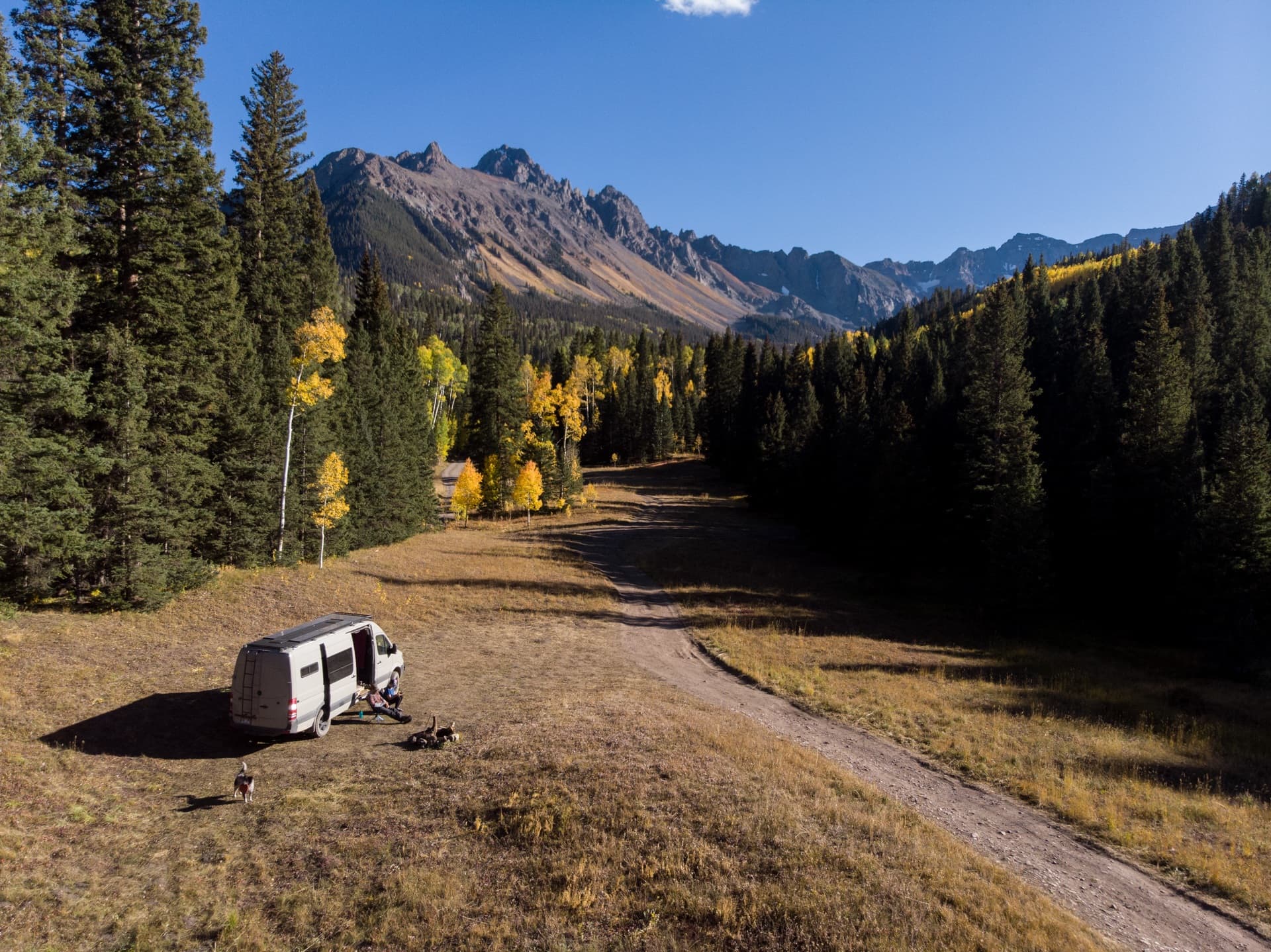
I’ve been doing van life for the last 9 years, and during this time I’ve tested just about every method and app out there for finding free campsites on public lands — also known as dispersed camping or boondocking.
In this post, I’m sharing exactly how I find quiet, beautiful, free places to camp, even in popular areas. I’ll break down which apps and websites I rely on (and which I don’t), plus how I go beyond the top search results to find campsites away from the crowds.
Whether you’re a new van lifer, an overlander, weekend road tripper, or just trying to stretch your travel budget, this guide will help you confidently find free campsites across the U.S.—and enjoy the kind of solitude and starry skies that make life on the road worth it.
This post may contain affiliate links.
Some Helpful Terms

Save this post!
Enter your email & I'll send this post to your inbox! You'll also receive my weekly newsletter full of helpful advice for planning your adventures.
Types of Public Lands Where You Can Camp for Free
Understanding different public land designations will help you find free campsites. For example, BLM (Bureau of Land Management) lands with dispersed camping are very common out west, but are non-existent in the midwest and along the entire east coast.
In those regions, National Forests, State Forests, and Wildlife Management Areas will be your best bet.
As a starting point, here’s a breakdown of the most common types of public lands that allow for free dispersed camping. After, I’ll get into the apps and tools I use to find actual campsites in these areas.
Note that the Forest Service and BLM also operate a ton of paid campgrounds, so not all camping on these lands is free.

My Step-by-Step Process for Finding Dispersed Campsites
After nearly a decade of van life, I’ve figured out a reliable system for finding free campsites—without spending hours scrolling through apps or ending up at a crowded pull-off. There are so many tools out there now, and it’s easy to get overwhelmed thinking you need to download them all. You don’t.
In this section, I’m breaking down the exact step-by-step process I use, including which apps and tools are actually worth your time (and money) and which ones you can skip.
1. iOverlander app
iOverlander is an app that’s long been a favorite among van lifers—and it just got a major update with the release of iOverlander 2. The platform relies on user-submitted info about campsites, making it one of the most comprehensive crowdsourced databases of free camping across North and South America.
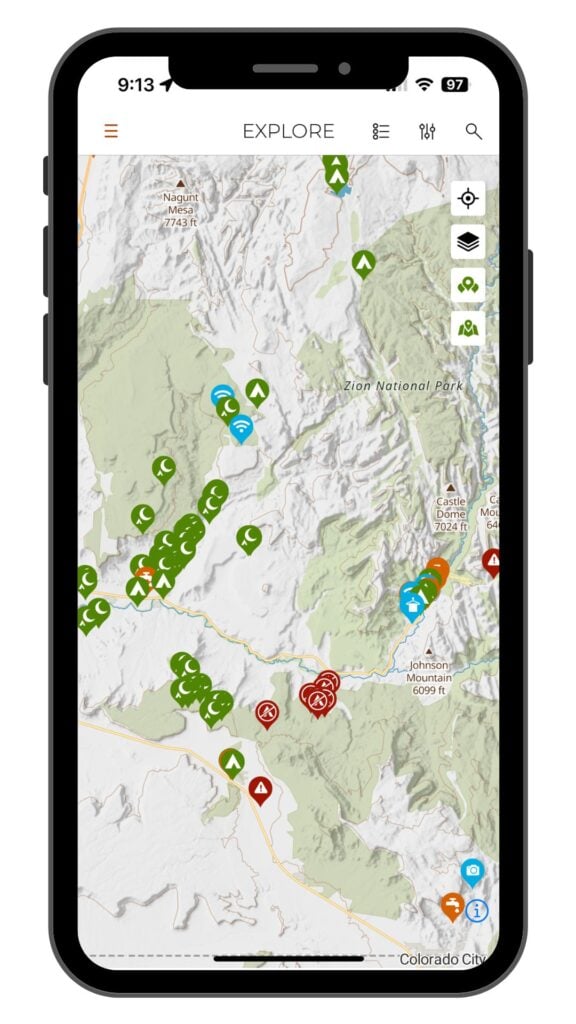
I’ve used iOverlander throughout my years of full-time travel, and it’s still the first app I open whenever I roll into a new area. While it doesn’t list every free campsite, it gives me a solid starting point. In my experience, if there’s one site on iOverlander, there are usually a few more unlisted spots nearby worth checking out—you just have to explore a bit (which leads to Step 2 down below).
iOverlander has a free and paid version ($5.99/month). I think the paid version is 100% worth it, primarily because it allows you to download regions for offline access so you can search for campsites on the go. This is valuable because sometimes you arrive at a site, only to find it’s already occupied by someone else already. In this case, I can open the app (even when I don’t have service) and see what else is nearby. It also allows you to download multiple regions to your phone at once, with access to different map layers.
Most recently, I used iOverlander extensively while traveling full-time in my Rossmonster adventure truck through Baja. It helped us find incredible beachfront campsites, along with places to fill water, do laundry and more —making it a go-to resource for full-time travelers.

One of the app’s best features are the user reviews and real-time updates. You’ll often find recent comments with road conditions, closures, safety notes, and tips that can save you from pulling into a site that’s no longer accessible. I also love how you can favorite campsites in the app, making it easy to return to places you love or bookmark spots that look promising as you’re planning.
One of the biggest downsides of iOverlander is that its most popular campsites can be, well…too popular. As more people rely on the app, many of the easily accessible or scenic spots—especially near national parks or along major road trip routes—see heavy traffic.
My advice? Use iOverlander as a starting point, but don’t stop there. If you find a marked site that looks crowded or worn down, drive a little farther down the road. Often, you’ll find lesser-used sites that offer more privacy and a better overall experience. The best campsites I’ve found rarely show up at the top of anyone’s list—they’re the ones I discovered by taking a detour or digging a little deeper.
2. Google Maps app
Once I’ve narrowed down the general area I want to camp — usually using iOverlander — I switch over to Google Maps in satellite view. This is one of the most useful and underrated steps in my process for finding free campsites that aren’t already listed in every app.
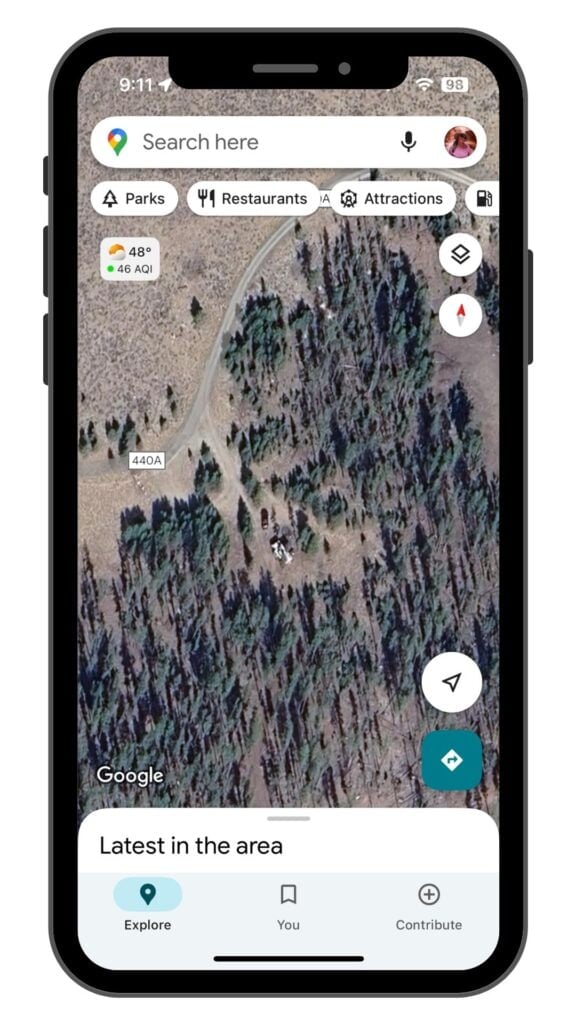
In Google Maps, I zoom in and look for pullouts, clearings, or flat areas along forest roads or inside BLM land boundaries. You can usually tell the difference between a true campsite and just a random clearing by zooming in and looking for signs of use, like a fire ring, a vehicle-sized bare patch, or a short spur off a main road. Sometimes you can even see RVs and trailers, which is a pretty sure bet that camping is allowed there.
Satellite view is especially helpful in areas where crowdsourced apps might only list one or two spots—but there are likely several more nearby. In case you didn’t know, you can also download Google Maps to your phone for offline use.
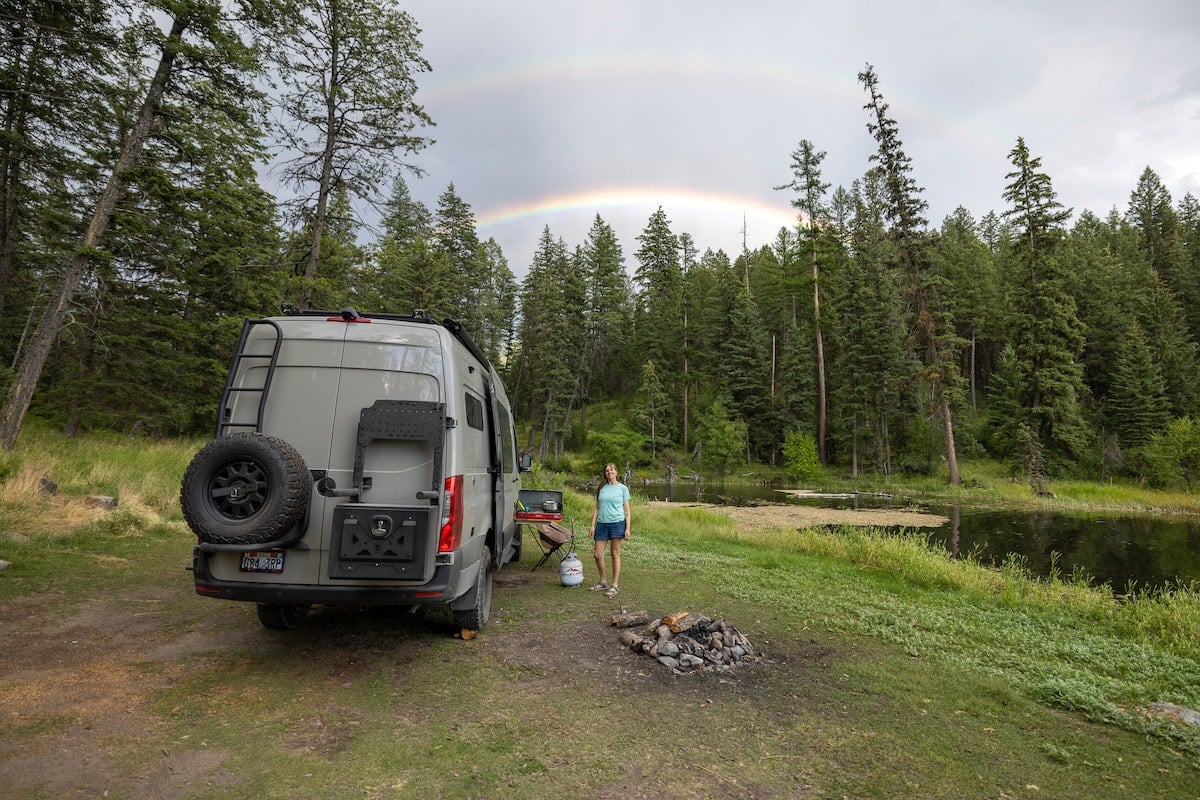
3. OnX Offroad app
After checking iOverlander and scouting with Google Maps, I’ll open onX Offroad. This is one of the most powerful tools I use to discover dirt roads so we can explore beyond the well-known campspots that are pinned in the popular apps.

What makes onX so helpful is its detailed trail and land use overlays. You can view dirt roads and trails color-coded by difficulty level, which helps me decide if I can safely access a spot with my rig. I can quickly tell whether a road is mellow and 2WD-friendly or if it’s going to require 4×4 and high clearance.
But what really sets it apart is the land ownership overlay. I can see exactly where the boundaries are between public and private land, so I’m not accidentally pulling onto someone’s property. It shows federal land like BLM, National Forests, and state-owned parcels—and there’s a layer that shows (in yellow on the map above) where dispersed camping is allowed.
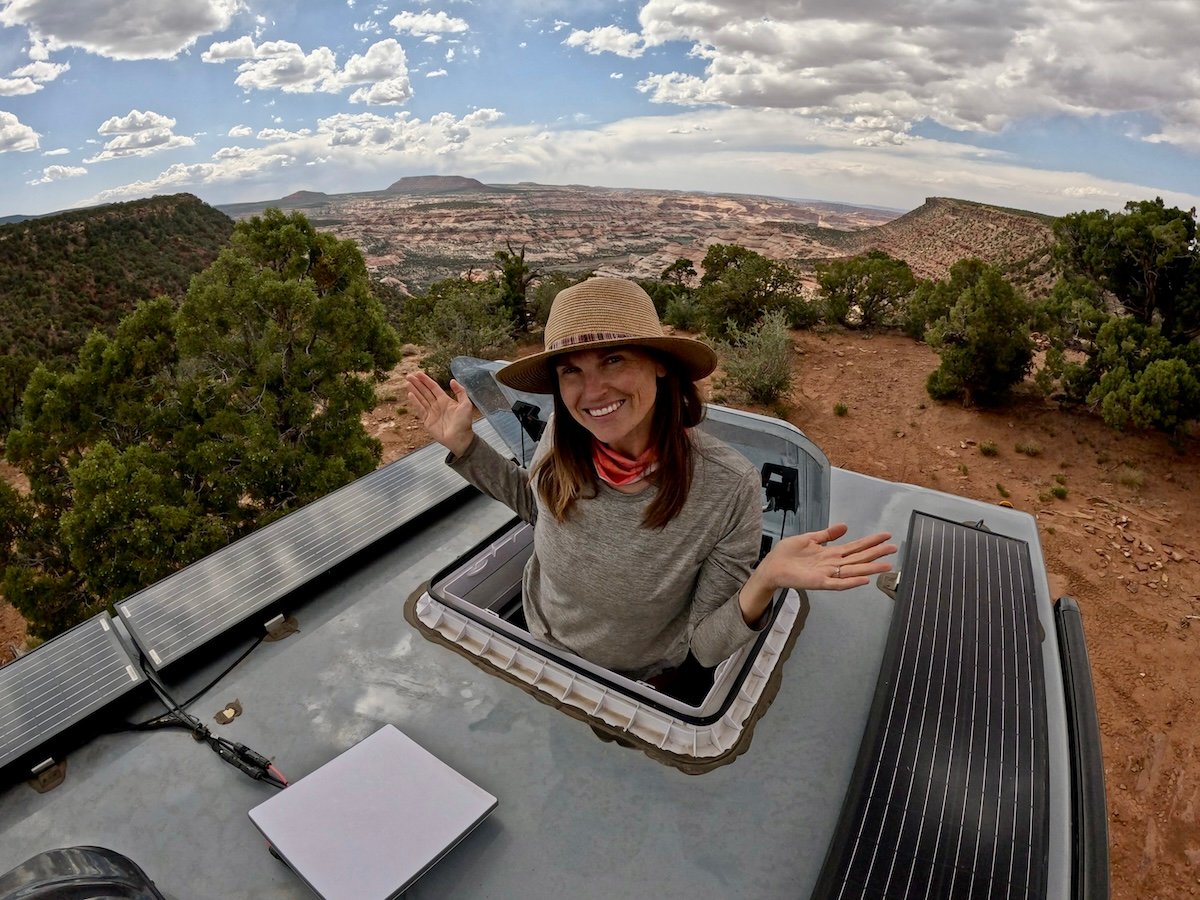
onX also lets you save maps offline, drop custom pins, and track your route in real time even when you don’t have service. This means you don’t have to worry about accidentally turning down the wrong road and ending up lost…which I have done in the past, and it’s not fun!
I don’t rely on onX alone for finding campsites, but when I want to be 100% sure I’m on legal ground, or I’m trying to get away from crowds and find something more remote, it’s one of my favorite tools. Memberships start at $34.99/year.
4. Benchmark Road Atlases
Since I now have Starlink on my roof of my truck camper and can always access the internet, I don’t rely on paper maps as much as I used to. Before I had a constant connection however, I was happy to have an old-school paper map to navigate with.
Benchmark Road Atlases are my go-to paper maps that are very handy for discovering free campsites sans technology. I own one of these atlases for every state I’ve spent an extended amount of time in. They generally run about $20 each, and the maps show recreation activities, established campgrounds, and public land ownership lines so you know if you’re on public or private land.
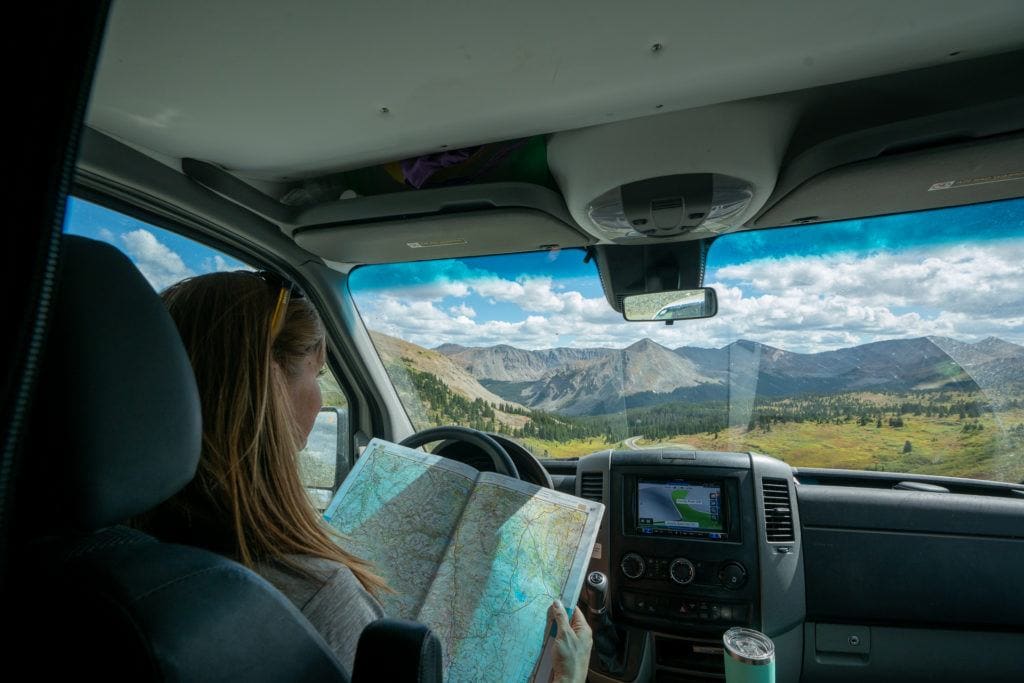
These maps also show dirt roads categorized by 2wd or 4×4, and in my experience, these indicators have been pretty accurate. When it says 4×4, the road really is rough. Just having a sense of the terrain and accessibility is a good place to start.
The way you can use these maps to find free dispersed camping is by looking for nearby dirt roads on public lands that your van or camper can handle, and then driving down them to explore. You won’t always find campsites this way, but when you do, it’s extremely satisfying.
Other Tools I use
While iOverlander, Google Maps, and onX Offroad are my core tools, I also use a handful of other apps and resources depending on where I’m traveling. These aren’t always essential, but they’ve helped me find last-minute spots, check land boundaries, or confirm whether overnight parking is allowed. Here are a few other tools I keep on my phone or bookmark for trip planning.
The Dyrt
I actually prefer using The Dyrt when I’m looking for paid campgrounds—especially if I want to book ahead or know exactly what I’m getting. The app has a huge database of campgrounds across the U.S., and what sets it apart is the volume of user reviews and photos.
Many reviewers even include specific site numbers, which makes it easier to avoid bad spots or snag one with shade, privacy, or a good view. You can also search by required amenities. Let’s say you need Wifi to get some work done or need a location with showers or even a pet-friendly location, you can narrow your search down using all types of parameters.
The Dyrt does include information on dispersed camping, but you’ll need a Pro membership to access those listings. The Pro version also gives you offline access, map overlays for BLM and National Forest land, and a few discount perks at select campgrounds. But honestly, I find that other tools—like onX or iOverlander—do a better job for free camping.
That said, if you’re planning a route that includes a mix of paid and free camping and you don’t want to go too remote, The Dyrt is definitely a solid planning tool. Check out my full Dyrt review for more thoughts.
*The Dyrt is currently offering a FREE 30-day membership to The Dyrt PRO to Bearfoot Theory readers (use the code “Bearfoot” if signing up on mobile!). Try it out and see how you like it!*

FreeCampsites.net
If you don’t want to download a paid app or prefer to search on a computer or browser, Freecampsites.net is a desktop tool that allows you to zoom in on a map to locate campsites wherever you’re going. Additionally, it also has a trip planning option that will allow you to create a route using free dispersed camping options. You can even search by the type of access road to the sites.
When you select a site, you’ll be given the GPS coordinates, elevation, and the local weather so you can pack accordingly. This isn’t my go-to, but I’ve found that freecampsites.net sometimes has free dispersed sites that aren’t found on iOverlander or other apps.

Harvest Hosts & Boondockers Welcome
Another great option is Harvest Hosts and Boondockers Welcome. Memberships start at $99/year, and as a Member, you get to park overnight for free at a variety of wineries, breweries, farms, museums, golf courses, and other attractions. We’ve even “camped” at ski areas and church parking lots. It’s not true camping, but it’s a much better option than stealth camping when you need a safe, legal place to park overnight.
Harvest Hosts is only for fully self-contained campers with a toilet, so if you are tent camping or sleeping in the back of your Subaru, you won’t be able to stay at Harvest Hosts sites. Use this link to get 30% off your first year with the code FRIENDS30.
Boondocker’s Welcome, their sister website, connects you with private property owners who welcome overnight campers. These are often in driveways, fields, or backyards and some allow multiple-night stays. You can add Boondockers Welcome to your Harvest Hosts plan for 30% off the first year as well. (Note: You also must be self-contained to use Boondocker’s Welcome).
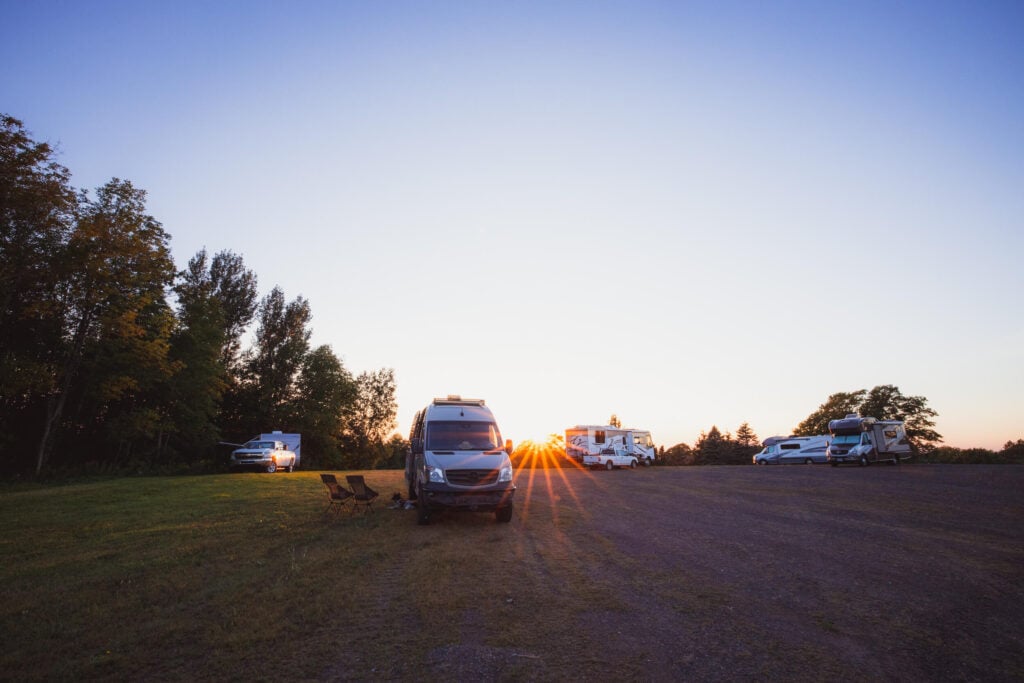
Helpful Tips for Finding Free Campsites
When you’re first starting out, finding free campsites might feel intimidating (I know it was for me). Here are some ways to ease into your first free camping trip:
Remember, it’s ok if you don’t have to have an Instagram-worthy campsite every night. Adopting this mindset will reduce the pressure to find the perfect free campsite. Some nights you might be in the forest with no view or you might be parked in a big open area near a lot of other campers.

When you end up staying at free campsites that are less than stellar, just remember that you can always pack up in the morning and move on to somewhere better. All you really need is a flat spot with enough space, and the biggest thing is that you feel safe at your dispersed campsite and you aren’t blatantly breaking the law.
Things to Know Before Camping at Dispersed Sites
One of the reasons I love dispersed camping is that it’s so much more peaceful and private than paid campgrounds. Plus, many free sites have even better views.
The sad thing is that many public lands that are at risk of being shut down due to overuse and because campers are trashing campsites, pooping and leaving toilet paper all over the place, and driving over vegetation to create new campsites. Basically there’s too may campers that have no respect for the environment that we are all out here to enjoy.
If you want free campsites to remain free, please follow Leave No Trace principles and keep the following in mind:
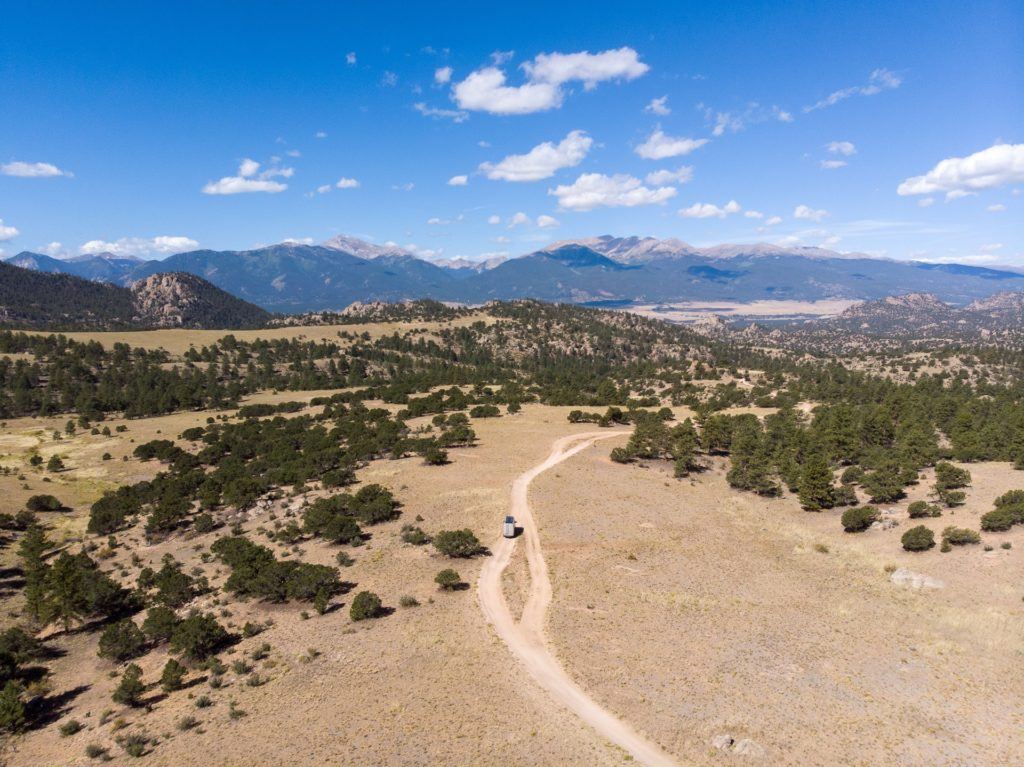
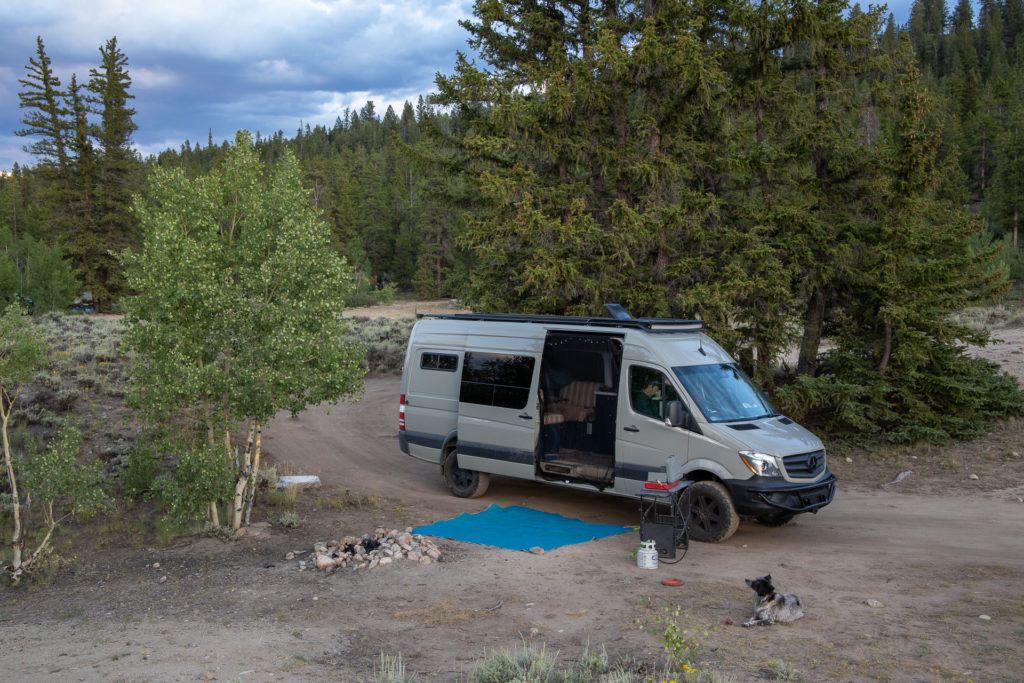
Is Dispersed Camping Safe?
Taking extra safety precautions when you’re camping is an important consideration, especially when free camping when you may be far away from other people and without cell signal. With that said, in my 9 years of van life, I’ve never encountered any issues while dispersed camping. However, here are a few ways to keep safety top of mind:
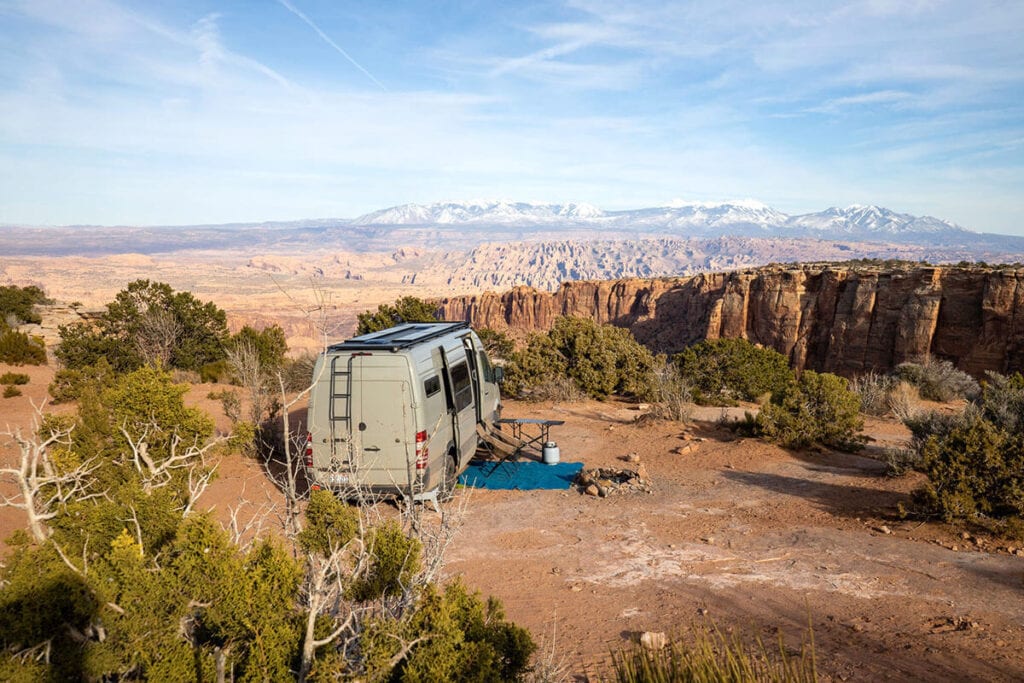
Options for Stealth Camping
I mentioned stealth camping at the beginning of this post, so I want to briefly touch on where you can stealth camp and sleep inside your vehicle. For more info, check out my post on how to stealth camp.
Here are some places you can stealth camp if you find yourself caught in town refueling on supplies and need a place to sleep for the night. Each location will have different rules, so your best bet is to look for signs or go inside and talk to the manager.
- Walmart
- Cabela’s
- Cracker Barrel (most have dedicated overnight parking spots in the back)
- Camping World (sometimes have free water, dump stations, and electrical hook-ups)
- Planet Fitness/Anytime Fitness/24-Hour Fitness
- Lowe’s/Home Depot/Menards
- Costco/Sam’s Club
- Casinos
- Rest Stops
- Truck Stops
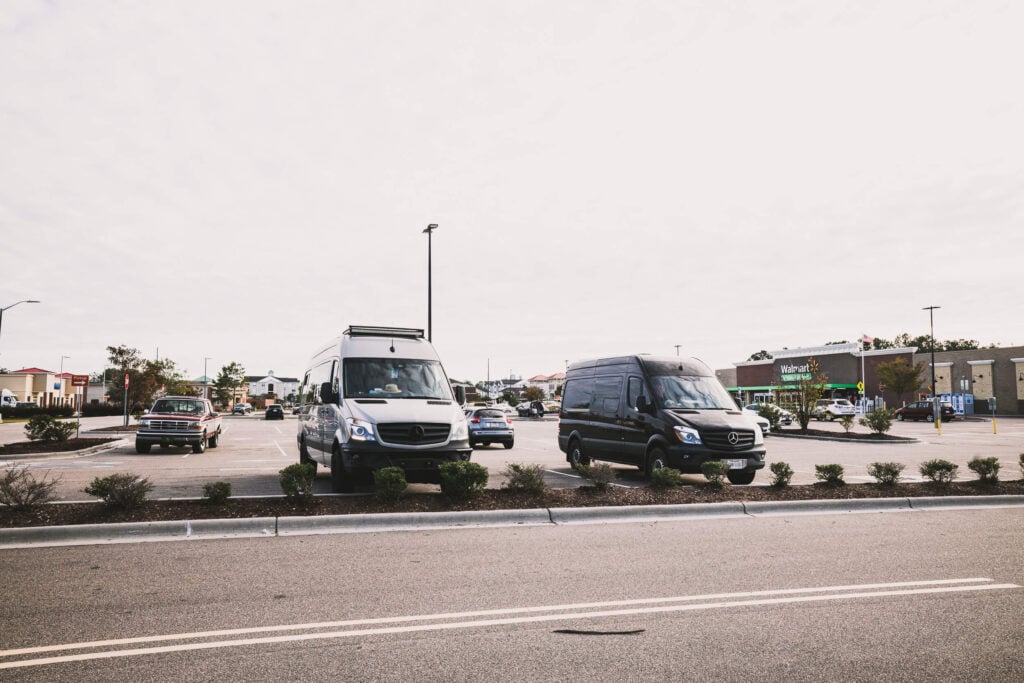
What questions do you have about how to find free campsites? Do you have favorite tools to find dispersed camping that I didn’t mention? Share your experiences and tips with boondocking below in the comments!

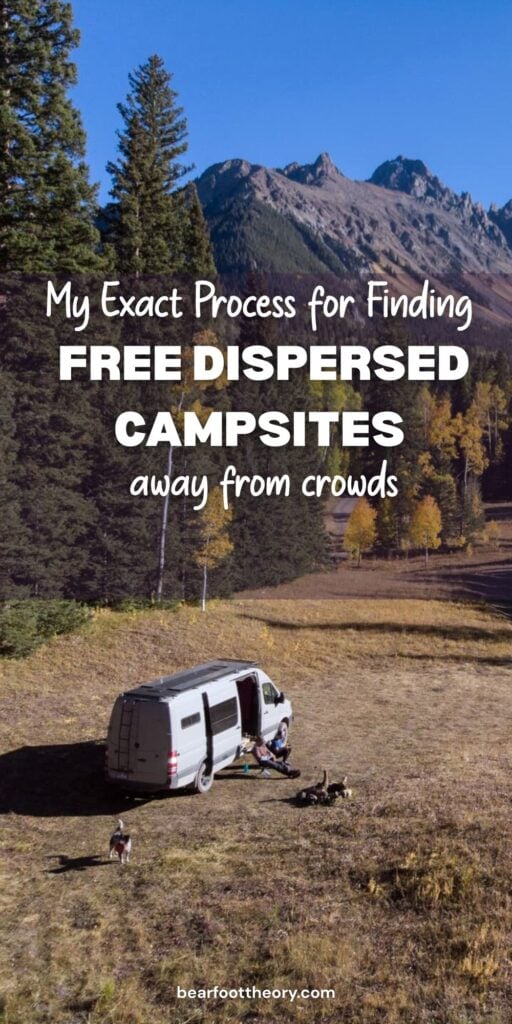
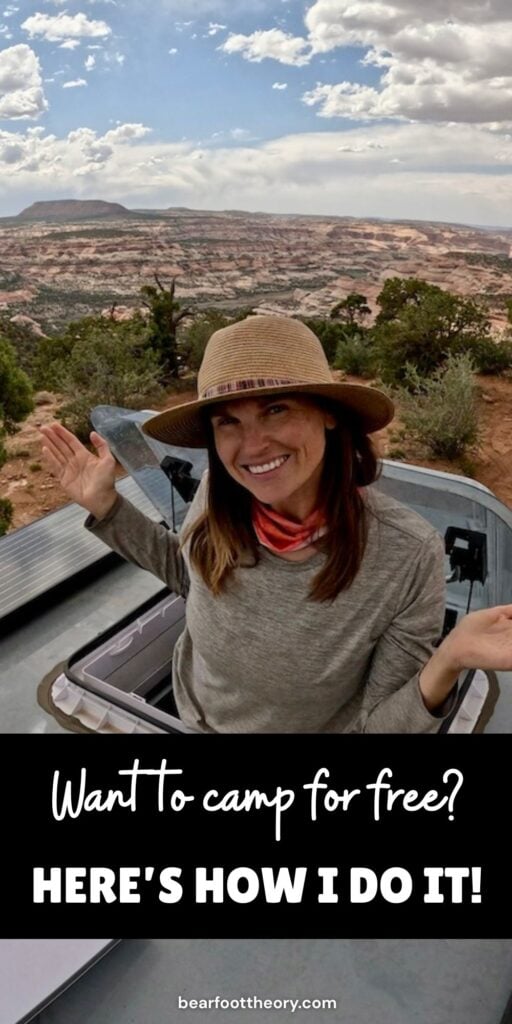

Great article! One additional resource that\\\’s awesome is the app Avenza PDF Maps. It\\\’s free, and you can get the USFS maps through this app in a much more convenient format than through the website. The PDF maps show forest roads and dispersed camping areas, and are georeferenced so you\\\’ll see exactly where you are on them. I highly recommend it for dispersed camping in National Forests and Grasslands.
Sweet. Thanks Steve! I’ll check that out.
I really enjoyed this read… Shared among some friends. In six years I’m retiring and living in Class A RV full time, much of this I did not even know was available but will now have this in the front of my mind so that we travel smart. Thanks So Much for all the information. xoxo from Indiana
Nice read. Thank you.
Thanks, this is a GREAT article, really appreciated it. Heading out in May, very timely
ioverlander helped me free camp across the US and Canada, it’s a pretty great free app. Canadian wild camping along the shore of the great lakes was incredible, you have to get up there! I’m so glad to have stumbled upon your site as I’m making a shift from car camping to backpacking. Such empowering content! Way to make adventure feel accessible 🙂 Thanks!
I enjoyed reading your article I got a lot of information I am learning about camping and about campsites and I found your information very helpful and useful thank you
Outstanding work.
Thank you so much for writing this comprehensive article! my husband and I have done most of our dispersed camping in AZ, we know the areas and back roads there. we recently moved to Nevada, I know most of the state is BLM land and probably fine to camp most places. But, we area 100% and having an app that doesnt need service to use the maps is amazingly helpful. 🙂
The free trial of TheDyrt Pro was such a brilliant and helpful find as I start planning my first big adventure. Thank you!
Hi Annie, we’re so glad you found The Dyrt Pro helpful! Hope you have a great time on your trip!
Please don’t try to fool people into believing wasp spray is good for defense. It is useless. It is mostly water with a few chemicals that that don’t sting or burn, even in the eyes. The perp may get cancer in 30 years. But that isn’t going to help them when they need it.
Thanks for letting us know! We’ve removed it from the post.
It is a good idea to travel with a satellite-based SOS device and subscription, such as Garmin InReach or Zoleo’s satellite communicator. When you do not have cell service, which many dispersed sites are lacking, you need to be able to contact someone for help in case of an emergency. The newer iPhones now have an SOS feature that might be all you need, but review the options and determine what would work best for you. Also recommend a portable power bank to recharge your phone or satellite communicator; a portable air compressor to fill up low tires; bear spray; and a portable car battery charger.
Hi Pat – yes I totally agree. I have a Garmin Inreach Mini that comes with me everywhere. In came in handy a couple years ago when we woke up to a dead van battery in sub 0 temps. I used it to text my dad who was able to arrange for someone to come help us. My partner Ryan is also type 1 diabetic, so it gives me peace of mind when we are hiking in case something were to ever go wrong. Thanks for sharing your thoughts! – Kristen